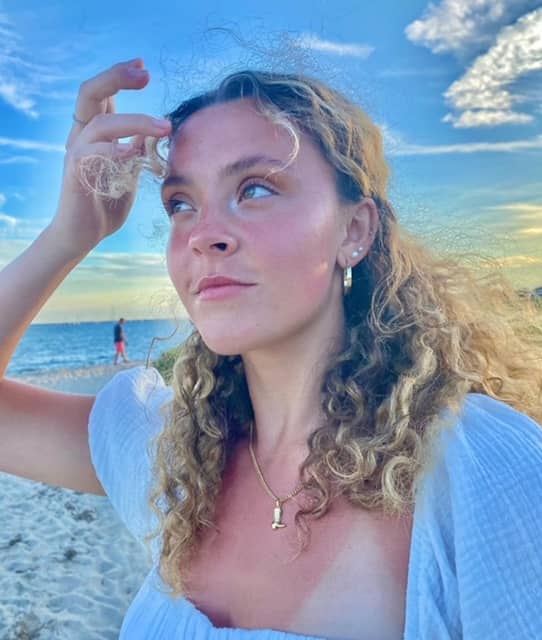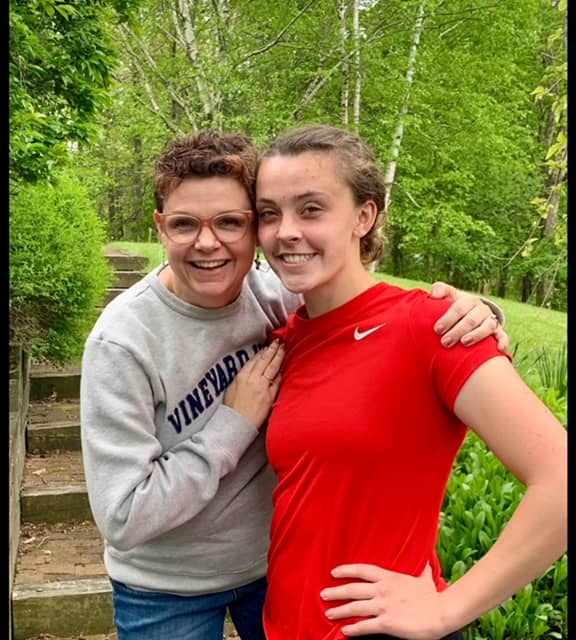A Parent's Journey

By guest writer, Tara Grieb
My daughter Kelcie has always been a strong girl; from year to year, milestone to milestone, she feared nothing and was often the champion for others. Like many kids, she tried a variety of activities, testing to see which would light a spark in her. As a school principal, I watched countless students choose and change pathways based on their interests and struggles, figuring out who they were and who they wanted to be. I witnessed many push themselves too hard or put all of their heart and soul into only one activity or facet of their lives, only to question their future if an injury or issue forced them to stop.
As a result, I constantly reminded Kelcie and all of my kids that they were more than athletes, students, fishermen, or artists. They were multifaceted people with much to offer and much to love. I always felt that they needed to be well-rounded so that should any of their interests give way, their lives weren’t shattered.
Unexplained Struggles
Kelcie started with dance and soccer, though she experienced a meniscus tear requiring surgery at age 13. During a testing rehabilitation program, she decided sports were where her heart lay and worked hard to come back stronger than before.
Yet, in the fall of her junior year, Kelcie experienced a mysterious illness that had us all stumped.
After passing out on the bathroom floor one morning, she was rushed to hospital for various tests. Over the next few weeks, we went from potential blood cancer to mononucleosis (glandular fever) until doctors finally landed on a "non-descript virus". In the ensuing months, her energy, her breathing, and her endurance would all suffer. That spring, COIVD-19 shut down the United States, and we decided that it must have been the “non-descript virus” that took her down just a few months before.
One year into the pandemic, Kelcie resumed sports as her school lifted restrictions. A breakup with her high school sweetheart caused her to look for other outlets to distract her from the heartbreak that so many of us have experienced. The gym and weightlifting gave her strength in a variety of ways.
She dropped weight and leaned out, which I attributed to the resurgence in athletics, the sadness of a breakup, and her new-found enjoyment in strength training.
Like others her age, Kelcie was attempting to select a college based on video tours and Zoom calls, unable to visit or sense the vibe of any of the schools that interested her. We discussed selecting a college for its academic programme and for having the lifestyle experience she was looking for. She knew she wanted a Division 1 athletic school and after an extremely successful (albeit short) track season the summer of 2021, she was offered her dream spot at a D1 school. All the stars had aligned, it seemed.
That summer, she had what we thought were some digestion issues. Gluten and dairy intolerance run in our family, and we had her tested for those and more. We cut out various foods, looking for the culprit, but with no luck. As she transitioned to college, the food issues continued, but we chalked them up to dining hall food and being unable to cook for herself. In the meantime, her athletic career began, and she soon realized how different college and college athletics were. As many do, she gained weight, adjusting to the food and the lifestyle. She tried the courses given to her, only to realize that what she thought she wanted to study wasn’t the right fit.
On the track, Kelcie wasn’t having the success she was used to. Her times weren’t decreasing, but she wasn’t improving, and she became more and more frustrated.
Through calls, visits, and countless FaceTime sessions, we would talk about her days, her frustrations, and her feelings. It was so hard to be so far away, and even harder to decipher the causes of the problems, let alone offer solutions. Call after call would be filled with anxious feelings, frustration, sadness, and self-criticism. I would do my best to offer support, solace, and encouragement. We enlisted the help of a therapist for her anxiety and frustrations, and that seemed to help.
At the tail end of her freshman indoor season, her shins began to hurt. This was nothing new. Compression sleeves were the norm for her, and she continued to use them. Trainers iced and wrapped her as needed, and all helped her "work through it". At her first outdoor meet, she ran a time she hadn’t run since 10th grade in one of her races and finished the race in tears. "That’s it," I said. We need to get to the bottom of this.
The diagnosis of stress fractures in both shins was devastating.
She would redshirt her season and work on rest and rehab. I watched as she struggled to feel good about herself, her progress, and her abilities. I would remind her of our high school conversations and that she was more than just an athlete. That she was strong, intelligent, and talented. I reminded her that her scholarship was based on her academics, proving further that there were many layers to who she was and where she found success.
None of it sank in, and I could see her spinning out. I could feel her anxious tension each time we chatted, regardless of the topic, and it broke my heart.
That semester, she continued in her decidedly wrong course of study, following what felt like a wrong attempt at college athletics, and continued to feel wrong all the way around.
A Turning Point
She continued with the counselor and found a better-suited course of study, which she would begin in the fall. As the year ended and she came home for the summer, we all looked forward to the new year. It would include new coaching staff, new paradigms, and hopefully, new beginnings. While it all seemed promising, her issues with her gut and feeling anxious continued. We chalked it up to fear of the unknown and moved on, still consulting with her doctors on each visit and hoping that with change there would be calm, solace, and peace.

When the time came to return to college, Kelcie was off campus with her own kitchen, her own space, and a new sense of hope. Just a few short weeks later, the shins began again. An MRI showed that the stress fractures had not healed. Months of rest, months of PT—for what? I shared her frustration, and we cried together on the phone.
She was seeing a new doctor on the college collaborative staff and would let me know how it went afterward. I will never forget the time she called me, sobbing down the phone. "Mom, we figured it out... This doctor is amazing. She started asking me questions about how I felt and how practice would go. She asked about my anxiety, my gut issues, and my training. It’s REDs, Mom."
I hadn’t heard of it. I couldn’t help; I was so far away, and all I could hear was the sound of her crying.
I fumbled on my computer, looking up the term while I talked to her. "Mom, finally, someone understands. She gets it. She started asking me these questions, and every answer was yes. Every thing, every feeling, was connected and brought me back to this. We tracked it all the way back to 11th grade, and finally, it all makes sense." "I’m so sorry, Kel," I said, still looking up the term and trying to understand. REDs, the Female Athlete Triad, it all suddenly started coming together. The master’s thesis I wrote on iron deficiency in female athletes in graduate school started coming back to me. Energy, bone density, performance, mental health, gut health, nutrition absorption—it was all there in a sea of words I couldn’t make sense of in the moment. "Mom," she said, "don’t be sorry; I am so happy, so relieved. I finally feel like someone gets it. She understood; she knew. It was like someone finally said words that made sense and was able to make sense of mine. It’s the beginning of the end of these issues." The next day, I sent the doctor flowers. She had no idea what she had done for my daughter, and the treatment plan hadn’t even started. She had no idea the connection and relief that were created after only one visit. I would have sent a room full of flowers if I thought it would express my appreciation. She called me soon after they were delivered, and we chatted for a few moments on the phone, both of us choking back tears. It was the beginning, and I was so thankful.
Lessons Learned
As I reflect on the journey and look back at the timeline, so many things now make sense. There was a period of time immediately following her diagnosis when I was angry at myself. How could I miss it? How could I accept all the false answers that we were getting and not connect the dots? Could I have stopped the growth of the problem if I had just figured out what it was? How could I not see what it was?
I realized, between berating myself and trying to figure out how I, her mother, could have missed such a long and detrimental process, that each step of the way, the answers made sense for the issue at hand. The non-descript virus was COVID. Weight loss, muscle gain, a breakup, a new hobby, weight gain, a plateau at school, the first year of college food, and new competition on the track; each step had an answer, and I didn’t connect the dots. I had to forgive myself. I had to understand that it wasn’t anyone’s fault, but it was something we would have to work on and move through. The school jumped into action, providing nutrition counseling, an orthopedist, a sports psychologist, and regular check-ups. The new coaches were amazing. Neither of them had experience with REDs, but both were eager to learn how they could support Kelcie as well as other athletes in the program. It is a slow journey, but it is a positive one. She and I have both transitioned to helping others become aware of REDs, its signs, and its dangers. We have both learned, and we have both become stronger because of our experience and our learning. In the end, the best advice I can give to other parents is to learn the signs, watch for them, and talk with your athlete. Be open and listen to their successes and challenges. Ask questions, and do not be afraid to enlist the help of experts. Most importantly, be kind to yourself. You are a great parent, and you are doing the best that you can.
